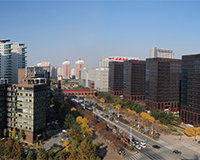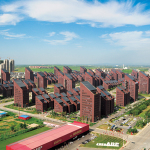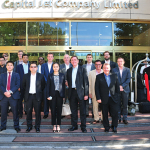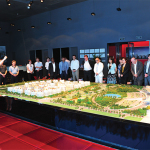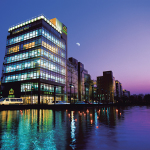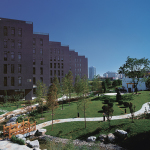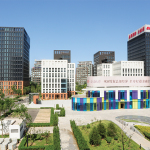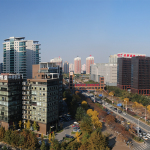Stepping into a private jet with ABP’s Xu Weiping, entrepreneur and Chinese property developer on a grandiose scale, you could be forgiven for forgetting that the Chinese market is in crisis.
But only last week the government cut interest rates for the fifth time since November 2014, and a short time before that it devalued the yuan by a further 3% to stimulate the economy.
But it is all smiles and small talk among the delegations from ABP and the UK as the plane takes off into the sunny Beijing sky – despite there already being some major indications of a stock market crash on the horizon.
As the plane weaves between the thunderclouds surrounding the city, generated by the oppressive Chinese summer, one cannot help wondering how much manoeuvring Xu has had to do. About 30% was wiped off the value of the Shanghai stock market in less than three weeks by mid-July, and the office and residential markets – which crashed in 2013-14 – are still slowly “rebalancing”.
It does not seem to bother the enigmatic developer, as he relaxes into the plump leather seats and jokes with members of Newham council. With thousands of offices in the pipeline across three enormous schemes in China – alongside a fourth in Beijing that is already complete, sold and profitable – he is upbeat about ABP’s prospects, especially its development of the Royal Albert Docks, E16.
Estates Gazette spent a week with ABP touring its Chinese projects and, at least as far as construction work can be any gauge of success, it seems to be very much business as usual.
Thinking outside the centre
In part, the reason for this optimism is ABP’s business model.
Instead of focusing on developing prime towers in city centre locations, it finds undeveloped land on the periphery of rapidly-growing cities that local governments are keen to develop. There ABP builds on a huge, but cheap, scale, creating hundreds, if not thousands of individual office buildings – and an entirely new business district.
According to Xu, shifting away from building in central business districts has been key to ABP’s success.
“Traditionally, in the city centre, if we want to make more profit, we increase the height or intensify the investment density,” he says.
“But we changed it fundamentally, through reform and innovation. We moved the CBD to the outskirts of the city, because it has a better ecosystem and traffic, to lower the investment and service costs.”
Local governments are keen to co-operate and attract this kind of investment, providing infrastructure to accompany schemes that bring them millions in business tax.
And, according to Billy Chau, Savills’ managing director for northern China,
it is still a good business model, despite the oversupply of office space in the Chinese market.
“ABP will normally not be in central business district areas, where land is expensive,” he says. “It will build in suburbs, where land is plentiful. Some businesses will not require offices in a very densely populated office area, and maybe they want more space, more accessibility or parking.
“These factors add together, and for the same money they can buy a building, instead of maybe two storeys in a CBD office. So they are more relaxed.”
It is a model designed to appeal to China’s expanding small and medium-sized enterprises, giving them the opportunity to own their own building outright, and to larger companies looking to open a regional office in key cities at a fraction of the cost of city-centre schemes.
ABP vice-chairwoman Nancy Xu – Xu’s daughter – explains that for a company growing up to a certain stage, it is important to show confidence and project a brand image to the market. “So to own your own building is very important,” she says.
Looking at the bigger picture
This is a model that has worked well for Xu on his one completed project, ABP Beijing, located in the Feng Tai district on the city’s Fourth Ring Road, the first stop on the tour.
Comprising more than 300 individual offices, it dwarfs ABP’s London project – and was built in just 10 years.
And it is popular. According to a spokeswoman for the project, all the units had been sold by the time it was completed in 2013, with prices nearly tripling per sq m between 2003 and 2011 as the area gathered momentum as a new business district.
But while the scheme may be big and successful, it is far from pretty. Jet-lagged and hot, we were chauffeured to the development on a grey Beijing morning, rolling past row after row of identical buildings, differentiated only by the neon corporate logos at their top.
The streets at ground level were almost deserted – especially by thriving Beijing standards – and there was little emphasis on retail or the creation of public realm. Over three days based in ABP’s Mayan-inspired hotel – itself seven converted office buildings – the area seemed quiet, despite employing 60,000 people. Finding somewhere to eat nearby was a difficult task.
But Zhang Bing, vice-general manager of Zebo, which manufactures and sells electronic musical instruments online, says his company moved to the area because of the better environment, better transport connections and government policies introduced to lure tenants – which include lower taxation and an easier registration process for staff from other parts of China.
Zebo is one of more than 500 businesses in the park, which range from telecommunications to construction, banking to steel.
And, as Xu says, the area was not built for Fortune 500 companies: “There are many companies in the world not ranked in the top 500 which have also made a good contribution to the world economy, and have enjoyed rapid growth, so ABP focuses on serving those companies.”
Tailoring to specific markets
Of course, ABP’s Beijing development was done and dusted before the Chinese economy slowed.
In a country containing 600 cities with a population of more than 1m people, there is still a lot of growth to tap into, although, according to Andy Wu, senior economist at RICS Hong Kong, it is the SMEs that will be hit hardest by the slowdown.
“Larger enterprises will hold out pretty well, because they are protected by the government, but the smaller ones will be in trouble,” he says. “One of the difficulties will be financing, because smaller companies do not have a lot of channels to the credit they need.”
That has not dented ABP’s enthusiasm for a Fordist level of office construction, but it has led to changes in its business model, with new schemes tailored more to their individual markets.
The sun was out on the drive to the airport to board a luxury jet chartered especially to show EG how ABP’s business model is changing – and conveniently skips the hassle of check-in by using the private terminals dedicated to China’s mega-money businesses.
From Beijing, we headed 1,200km south to the banks of the Yangtze River – and the relatively small city of Haining – to ABP Southern Yangtze, a 2,000-unit project spread over 12 sq km on the periphery of the city. In a peripheral location, Southern Yangtze is 40 minutes from Hangzhou and 90 minutes from Shanghai, and the scheme intends to tap into the incredible economic growth of China’s Zhejiang region – one of the country’s most affluent.
The project spokesman says: “The area has the most developed private economy in China, with SMEs gathering here, and these private companies need space to produce, design and show their product.
Here, ABP is trying to develop its factory store concept – essentially rolling offices, retail, design and production into one – providing office and development space for the mass-manufacturing sectors located nearby.
Individual offices are complemented by nearby retail outlet stores, where products can be displayed and sampled, tapping into what Xu and ABP call the Online to Offline (O2O) offering – an online experience with an offline delivery.
So far, just a handful have been built, but, incredibly, ABP intends to complete phase one in less than eight years.
Our delegation moves around some of the show units as the heat rises to 35°C, joined by the mayor of Haining and the local official of the Central Committee of the Communist Party, who are there to welcome Newham council and sign a friendship agreement to explore options for future trading.
The local government has been instrumental in providing infrastructure for the scheme, namely roads, and it and ABP are keen to publicise the area’s potential for UK companies – and especially their brands – as a construction base.
Alan Liu, managing director of north Asia at Colliers International, says the Haining area and anything along the corridor to Shanghai is well placed to see a lot of future growth, although he cautions about the absorption rate in such an area.
“Business parks with 10-storey structures, generally it does take time to dissipate – it is not a very quick process,” he says. “Most new buildings will take quite a bit of time to absorb, because the demands for space are generally not big from local companies.”
Judging by the scale of the scheme and the speed of construction, Xu is not worried, but it is still a tremendous amount of development in progress with the economy on the ropes.
A more conservative approach
Liu was less confident about the prospects for other cities in China, particularly those not in the first tier.
It is a thought echoed by Wu, who says the economic slowdown will hit occupier activity, leading to “SMEs and larger firms exercising a cautious approach to space all around, not just in the CBD”.
Qingdao, about 800km to the south-east of Beijing and the third stop on the tour, is one such city that has weaker prospects for future growth.
Xu and ABP are hoping to tap into the status awarded to Qingdao as a deputy province city, giving it significantly more political clout. Nevertheless, ABP’s scheme there is more conservative in scale, comprising around 80 buildings and 6.5m sq ft of space. At the moment, around 24 have been built, with the site scheduled for completion by 2019.
On a flying visit – the development’s proximity to the airport means EG is in and out in just three hours – and in sweltering humidity, we were ushered by ABP staff around the Georgian and neo-classical-fronted buildings of phase one, 40% of which has apparently been sold.
The top floors of the offices have been converted into luxury residential spaces, not for individual sale but as a base for the company executives when in that city – a model that Xu is keen to expand.
But according to the ULI’s analysis of the Chinese mainland real estate markets in 2015, the investment prospects for Qingdao are poorer than for an area such as the Southern Yangtze.
One analyst notes: “The market size is very small. Multinational corporations won’t set up large offices in Qingdao. The branches in Qingdao only cover the Shandong province.”
Oversupply and weak demand
According to the ULI report and a number of other commentators, nowhere in China is rated lower in its investment prospects than the north-eastern city of Shenyang, which is suffering from considerable over-development and a stagnant local economy.
The last stop on the tour, our jet flies low over the mountainous northern Chinese landscape, the Hunhe River glinting in the evening sunlight below, before we are ferried
through the city and out to ABP’s park.
As we roll through the balmy evening, ABP’s scheme seems to stretch for miles, though there are not many logos atop the buildings and some are still just shells.
In a city that is home to about 7m people, ABP is building an enormous scheme of more than 2,000 individual office buildings. Currently, 400 units have been built, and 350 of them are apparently sold.
ABP will not comment on whether it is worried about oversupply in the market, although there are two further phases planned for the scheme and Xu is confident about further expansion. With the city’s massive industrial base moving slowly to a more service- and design-oriented economy, he still believes there is a considerable market for ABP’s product.
Drive for decentralisation
ABP is upbeat about the effects of the economic slowdown on its developments, and Xu says
it has changed its model sufficiently for local economies – although there is little evidence of
this in its Shenyang or Qingdao schemes.
As long as ABP can sell the initial units, the state of the Chinese economy or real estate industry is irrelevant – which is one of the advantages of building smaller units and selling them, as opposed to CBD towers, which consistently have to be let. It is a model that has worked well for ABP, and still holds credence with agents in China.
Liu says: “There is a huge drive for decentralisation, so what has done well, other than occupancy on prime, is that a lot of offices have gone outside the CBD. That is definitely a strong trend, and rent and demand are all healthy. If you have a big area with reasonable quality, there will be demand there – the caveat is that you have reasonable quality.”
By developing smaller offices, but on a mass scale, and using the initial presales to fund subsequent phases of construction, ABP clearly thinks it can circle the storms in the Chinese economy. However, one of the reasons it is developing in London is to diversify that risk.
Our return flight to Beijing was – perhaps prophetically – delayed by storms pounding the city. With the latest manufacturing figures showing that factory output contracted by its biggest rate in three years, and an increasingly sceptical view being taken of official government GDP estimates, there could be more on the way.
The scale of what ABP is doing in China is undoubtedly impressive, but that does not by any means guarantee success. China’s ascent may be assured, but there will be turbulence.
Interview: ABP’s Xu Weiping
Enigmatic and flamboyantly dressed, Xu Weiping stands out from the crowd of Chinese property developers and officials. In London he has caused a stir not just for
his dress sense, but for his huge plans for the redevelopment of the Royal Albert Docks, E16.
It is difficult to get under the skin of anyone through the barrier of a translator, which is a shame when the man behind more than 4,000 offices in China is apparently quite the wordsmith.
Despite this, when meeting Xu on the top floor of his office building on the outskirts of Beijing, he appears relaxed and candid.
Popular presence
Likening his career in private business to the transformation of China’s economy over the past 30 years, Xu left the state-run Rural Economics Research Centre in the late 1980s with just Rmb2,000 in his pocket – about £150 at the time.
He made his first “fortune” selling fans – Rmb150,000 (£15,000) – but he did not move into real estate until the turn of the millennium.
His first project, in Beijing, started in 2003. Rather than entering the market as another CBD office developer, he found a new niche: providing office space for SMEs on the outskirts of cities – offices that they can own outright.
“We got away from the city centre and created a brand new park in this area to serve those SMEs,” he says. “At first it was slow, because it lacked a relatively mature business environment. But the economic growth was better than in the city centre.”
It is a model that would cause consternation in the UK – cheap, sprawling, mass-produced office accommodation on the outskirts of cities – but it is one that has proved popular in China. There are thousands of units in the pipeline.
Xu admits there were mistakes in the Beijing scheme, but says many of ABP’s experiences in China will be applied in the UK.
The ABP business model will remain, providing buildings that can be bought affordably by London-based or international occupiers and developing outer-city land that has excellent transport connections.
“The one experience we will apply in London, just like we did in China, is to continue to serve those SMEs,” he says. “We will not compete with Bank or Canary Wharf in serving those Fortune 500 companies, but we will focus on medium-sized ones.”
Xu says ABP will attract international tenants by creating a good business environment at the Royal Albert Docks, improving the construction quality and creating a platform for international trade.
He also says ABP has developed a “very good system” to bring in private and institutional investors, although it will remain the majority shareholder.
Free economic environment
Xu is not worried about the Chinese economic situation either, saying he believes that in the next three years, the Chinese government will transform the economic structure, making it more intensive and market aligned.
“I think the result of the transformation will turn the economy into a healthier one which is better for development,” he says. “ABP has every confidence in the development of the Chinese economy, and at the same time it is conducting its own transformation.”
Xu, unsurprisingly, considers himself a fan of the free market, likening the UK economy to a safari park and the previous Chinese system to animals in a cage.
“China is transforming from a planned economy to a market economy, so Chinese people and entrepreneurs are eager for the free economic environment, as long as they behave within the law,” he says.
But Xu adds that he is not really motivated by profit. “Profit is not my first target. To develop a good model is my career goal. I can co-operate with governments to stimulate the development of the local economy. ABP just wants to build a platform, so the companies within the platform can create more tax revenue for the government.”
Potential for transformation
Despite a degree of scepticism around his ability to deliver in the UK, Xu is big business in China. His schemes add millions to local economies and thousands of jobs, giving them the potential to totally transform an area.
The deference shown to him by everyone we meet in China is hard to miss, as is the clout he seems to wield as he takes EG around ABP’s projects in China, producing local politicians and party officials as and when needed.
He is open about his experiences, and his plans for the UK – but is suitably vague on a number of issues – and says that he has a vision for the docks, and that the project remains his top priority.
“I will invest much more time and energy in building this project into a great one,” he says. “It will be a combination of the occidental and oriental culture, and it will surprise you.”







